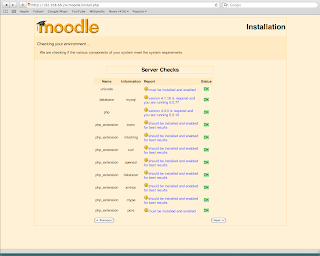#HOST=127.0.0.1;for((port=1;port<=65535;++port));do echo -en "$port
";if echo -en "open $HOST $port\nlogout\quit" | telnet 2>/dev/null |
grep 'Connected to' > /dev/null;then echo -en "\n\nport $port/tcp is
open\n\n";fi;done
if you need pls change ipaddress and you can add more number 65535
Red Hat, Fedora, Gnome, KDE, MySQL, PostgreSQL, PostGIS, Slony, Zarafa, Scalix, SugarCRM, vtiger, CITADEL,OpenOffice, LibreOffice,Wine, Apache, hadoop, Nginx Drupla, Joomla, Jboss, Wordpress, WebGUI, Tomcat, TiKi WiKi, Wikimedia, SpamAssassin, ClamAV, OpenLDAP, OTRS, RT, Samba, Cyrus, Dovecot, Exim, Postfix, sendmail, Amanda, Bacula, DRBD, Heartbeat, Keepalived, Nagios, Zabbix, Zenoss,
Tuesday, October 19, 2010
CentOS /Fedora /RedHat /Ubuntu if disk space is low send mail
PATHS="/export/home /home"
AWK=/usr/bin/awk
DU="/usr/bin/du -ks"
GREP=/usr/bin/grep
DF="/usr/bin/df -k"
TR=/usr/bin/tr
SED=/usr/bin/sed
CAT=/usr/bin/cat
MAILFILE=/tmp/mailviews$$
MAILER=/bin/mailx
mailto="rajat@yeswedeal.com"
for path in $PATHS
do
DISK_AVAIL=`$DF $path | $GREP -v "Filesystem" | $AWK '{print $5}'|$SED 's/%//g'`
if [ $DISK_AVAIL -gt 90 ];then
echo "Please clean up your stuff\n\n" > $MAILFILE
$CAT $MAILFILE | $MAILER -s "Clean up stuff" $mailto
fi
done
Installing subversion with apache on centos
Subversion exists to be universally recognized and adopted
as an open-source, centralized version control system characterized
by its reliability as a safe haven for valuable data; the
simplicity of its model and usage; and its ability to support the
needs of a wide variety of users and projects, from individuals to
large-scale enterprise operations.
Go to subversion.conf in /etc/httpd/conf.d/. Edit as below
cd /etc/httpd/conf.d/
vi subversion.conf
#yum install mod_dav_svn subversion httpd
#service httpd start
Go to subversion.conf in /etc/httpd/conf.d/. Edit as below
cd /etc/httpd/conf.d/
vi subversion.conf
This is a configuration with username and password
for the client
#htpasswd -cm /etc/svn-auth-conf rajat --- This command is not needed for the first configuration.
To create the first user with password
#htpasswd -m /etc/svn-auth-conf --- use this command to add another user
Configure your repository
#mkdir /var/www/svn --- create folder svn
#cd /var/www/svn --- change diectory to the newly created svn directory
#svnadmin create repos --- create svn repository named repos
#chown apache.apache -R repos --- change ownership of 'repos' to apache
#/etc/init.d/httpd restart --- restart apache
Open you browser and type 'http://localhost/svn/repos'.
Installation Moodle on CentOS / Fedora /RedHat
Moodle is a Course Management System (CMS), also known as a Learning
Management System (LMS) or a Virtual Learning Environment (VLE). It is a
Free web application that educators can use to create effective online
learning sites.
#yum install mysql mysql-server httpd php php-mysql php-gd php-imap php-ldap php-odbc php-pear php-xml php-xmlrpc
#service httpd start
#service mysqld start
#mysql_secure_installation (set up root password)
# tar zxvf moodle-weekly-19.tgz
#mv moodle/ /var/www/html/
http://yourdomin.com
vi /var/www/html/moodle/config.php
php /// Moodle Configuration File
unset($CFG);
$CFG = new stdClass();
$CFG->dbtype = 'mysql';
$CFG->dbhost = 'localhost';
$CFG->dbname = 'moodle';
$CFG->dbuser = 'root';
$CFG->dbpass = 'password';
$CFG->dbpersist = false;
$CFG->prefix = 'mdl_';
$CFG->wwwroot = 'http://192.168.68.24/moodle';
$CFG->dirroot = '/var/www/html/moodle';
$CFG->dataroot = '/var/www/html/moodle/moodledata';
$CFG->admin = 'admin';
$CFG->directorypermissions = 00777; // try 02777 on a server in Safe Mode
$CFG->passwordsaltmain = 't16y.SrDkojXnad5a&<8.Yw!';
require_once("$CFG->dirroot/lib/setup.php");
// MAKE SURE WHEN YOU EDIT THIS FILE THAT THERE ARE NO SPACES, BLANK LINES,
// RETURNS, OR ANYTHING ELSE AFTER THE TWO CHARACTERS ON THE NEXT LINE.
#yum install mysql mysql-server httpd php php-mysql php-gd php-imap php-ldap php-odbc php-pear php-xml php-xmlrpc
#service httpd start
#service mysqld start
#mysql_secure_installation (set up root password)
# tar zxvf moodle-weekly-19.tgz
#mv moodle/ /var/www/html/
http://yourdomin.com
vi /var/www/html/moodle/config.php
php /// Moodle Configuration File
unset($CFG);
$CFG = new stdClass();
$CFG->dbtype = 'mysql';
$CFG->dbhost = 'localhost';
$CFG->dbname = 'moodle';
$CFG->dbuser = 'root';
$CFG->dbpass = 'password';
$CFG->dbpersist = false;
$CFG->prefix = 'mdl_';
$CFG->wwwroot = 'http://192.168.68.24/moodle';
$CFG->dirroot = '/var/www/html/moodle';
$CFG->dataroot = '/var/www/html/moodle/moodledata';
$CFG->admin = 'admin';
$CFG->directorypermissions = 00777; // try 02777 on a server in Safe Mode
$CFG->passwordsaltmain = 't16y.SrDkojXnad5a&<8.Yw!';
require_once("$CFG->dirroot/lib/setup.php");
// MAKE SURE WHEN YOU EDIT THIS FILE THAT THERE ARE NO SPACES, BLANK LINES,
// RETURNS, OR ANYTHING ELSE AFTER THE TWO CHARACTERS ON THE NEXT LINE.
Subscribe to:
Posts (Atom)














